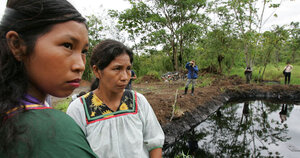Enviro-prize irks Chevron

Cofan indigenous women stand near an open oil pit in the Sucumbios province in Ecuador's Amazon in this 2005 file photo.
AP Photo/Dolores Ochoa
On Monday, two Ecuadoran activists who are demanding that the Chevron Corporation clean up a major toxic waste spill in the Amazon rainforest received the world's most prestigious environmental award. Now Chevron is mounting a public relations campaign to tell its side of the story.
Luis Yanza and Pablo Fajardo, two winners of the 2008 Goldman Environmental Prize, filed a class-action suit in Ecuador against Texaco, which was bought by Chevron in 2001. They claim that, between 1964 and 1990, Texaco dumped 18 billion gallons of drilling wastewater into the rainforest around Lago Agrio, a town in northwestern Ecuador, contaminating the land and threatening the health of the 30,000 Indians and peasants who live there.
Their case was bolstered in the first week of April, when an independent geological engineer recommended to the Ecuadoran judge that, if Chevron loses, the company should pay $8 billion to $16 billion in damages.
Chevron is taking steps to defend its image. According to the San Francisco Chronicle, the oil giant announced over the weekend that it had hired Sam Singer, the California PR consultant who famously helped the San Francisco Zoo flip the script on their Christmas Day tiger attack. On Tuesday, Chevron took out a full-page ad in the Chronicle, calling Mr. Fajardo a "front man for a group of Ecuadorian and American trial lawyers" trying to squeeze money out of the company. That same day, the Chronicle published an op-ed by Chevron's vice president and general counsel, under the headline, "Chevron victim of a shakedown." The company also maintains a website describing how they see it.
Chevron acknowledges the spill, but the company claims that the plaintiffs are pointing the finger at the wrong company, arguing that Petroecuador, Ecuador's state-owned oil company, is the real culprit. They argue that Texaco was a minority partner in the drilling operation, owning only 37.5 percent. Moreover, they claim that they have already paid $40 million in cleanup costs (which they say is reflective of its one-third share) and received a release of liability from the Ecuadoran government. Chevron says that Petroecuador, which has been the sole operator of the oil fields, has failed to live up to environmental commitments. By going after Chevron, their argument goes, the plaintiffs are providing cover for Petroecuador to continue to pollute.
Fajardo and Yanza have responded to Chevron's PR campaign with an open letter to the company's CEO, in which they argue that Texaco designed and installed an environmentally destructive production system and served as its sole operator for 26 years. The $40 million cleanup effort, they say, was merely cosmetic. Two groups opposing Chevron, Amazon Watch and Frente de Defensa de la Amazonía, have set up ChevronToxico, a website countering Chevron's claims.
Both sides agree that the region continues to suffer from severe environmental degradation. In a 13,000-word profile of Farjado that ran in Vanity Fair's May 2007 issue, journalist William Langewiesche describes walking with an Ecuadoran settler in the forest around an old oil well:
To get a sense for a place it is essential to walk the ground and poke around, unencumbered by itineraries and expectations. The settler led me down a short muddy trail to the waste pits from the old oil well. There were three of them there. One lay open to the sky in close to its original condition—a pond of thick, black, evil-looking liquid in which somehow a bird had just drowned. We walked along a dike to where liquid from an old siphon pipe still trickled down a slope and into a small stream below. The two other pits lay a little farther on. They were covered with dirt and overgrown by grasses. In places the wastes oozed up from below and formed asphalt patties that were hard on top and gooey on the underside. The area was suffering from a drought.
This contamination affects an area about the size of Rhode Island.
